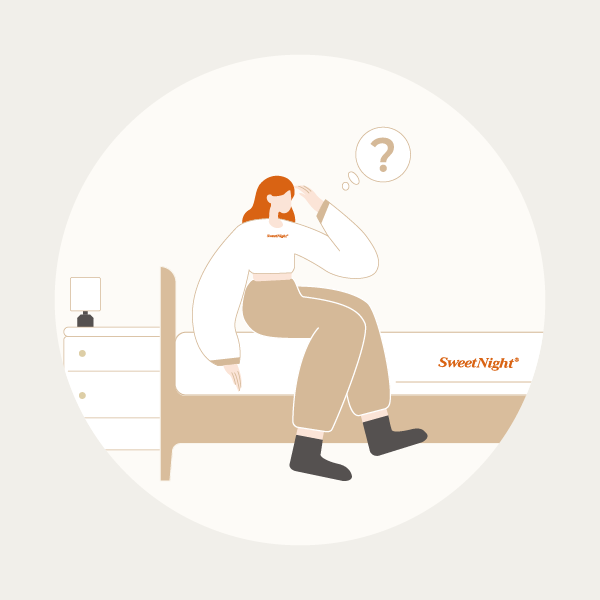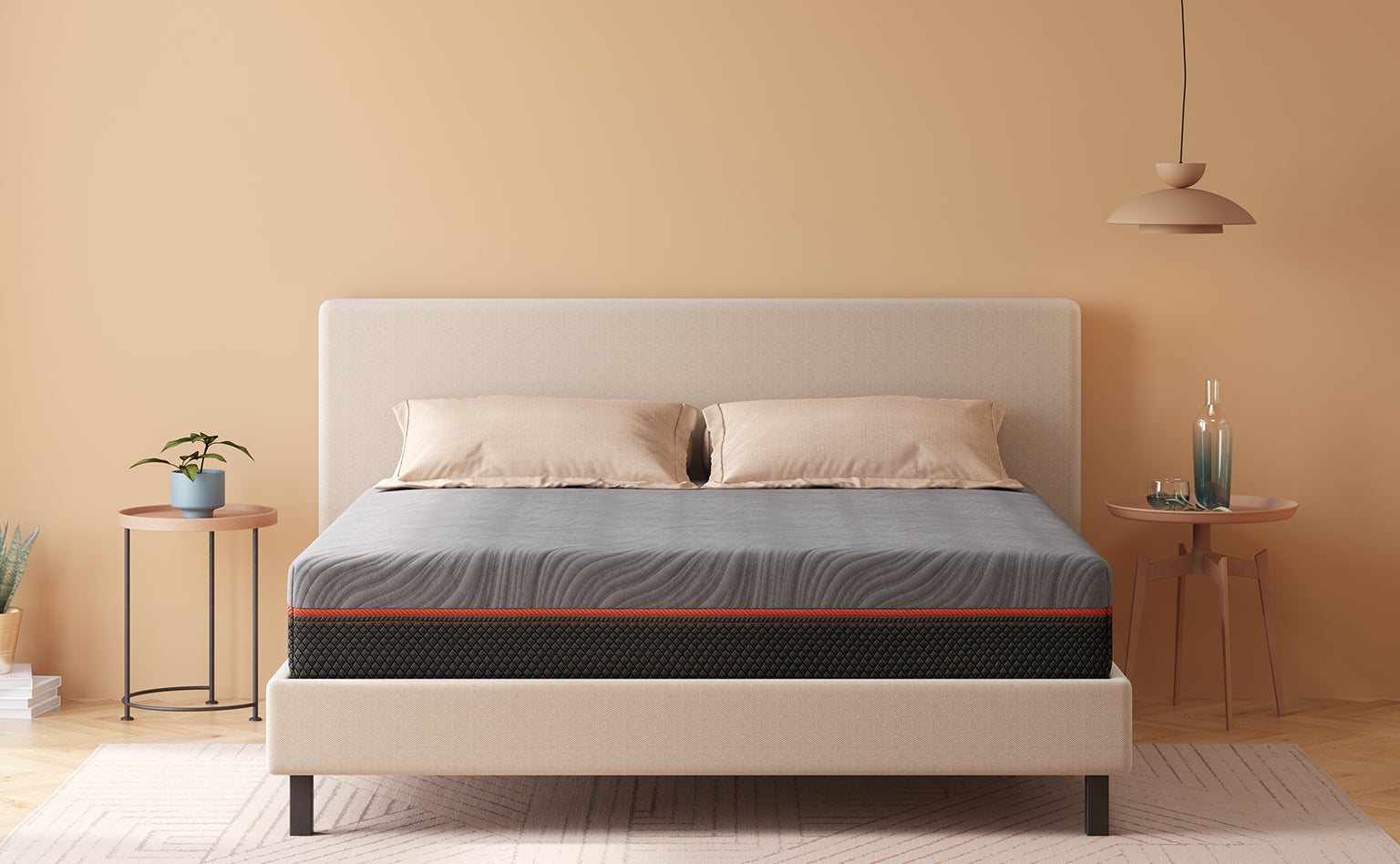Sleep & Health
HOW TO CHOOSE
A MATTRESS
Fact-checked By: Dr. Craig Liebenson, Certified Pain Management, Rehabilitation & Sports Health Professional
So you've decided to buy a new mattress. Congratulations!
You've finally realized that perhaps the previous mattress is getting a bit old or you're no longer getting that same comfort and support for a good night's rest.
Quality sleep should be restorative. Lack of appropriate sleep can occur for several reasons, but body pain is a leading factor in hindering quality sleep. A key question arises: what can you do to improve your sleep? Your mattress plays a significant role in ensuring a good night's sleep. If you're unsure where to start, this buying guide will help you learn how to choose the right mattress.

IMPORTANCE OF SLEEP
Why a good night’s sleep is so important?
Sleep is important...!
We all know it’s important. It’s important for reducing musculoskeletal pain, relieving stress, and improving your own energy levels. Most of all, it affects your overall feeling of well-being.
The list goes on regarding all the positive health benefits of sleep. I am sure most people have read it from popular magazines to countless articles on health or social media feeds. So, what is the impact of poor sleep quality you may ask.
It has been shown that getting less than 7-8 hours of sleep reduces cognitive abilities. "You really need to sleep to keep a healthy brain because it links electrical activity to a practical housekeeping function.” (Maiken Nedergaard Scientific American).
“Sleep physically washes toxins, including those that can lead to Alzheimer's, from your brain”
——Laura Lewis, Boston University published in The Journal Science
Sleep problems or sleep deprivation are detrimental to physical and mental health. It is usually under-recognized as a major health problem.
Did you know that sleeping less than 6 hours a night increases mortality risk. Poor sleep leads to a 48% increase in cardiovascular disease, a 23% increase in hypertension, a 15% increase in strokes, and a 9% increase in type 2 diabetes.
According to Caggiari (2021) “A meta-analysis on sleep quality showed that 15-30% of adults report sleep disorders, such as sleep onset latency (SOL), insufficient duration of sleep and frequently waking up at night.”
“Sleep physically washes toxins, including those that can lead to Alzheimer's, from your brain” (Laura Lewis, Boston University published in the journal Science)

WHAT AFFECTS QUALITY SLEEP?

It turns out that there are many variables that could affect the quality of sleep. It could be how much exercise you are getting a day, the noise outside your window, the temperature of your room, the emotional state of the sleeper, what time you had your last cup of coffee and even how comfortable you feel on your mattress. When we put it into this perspective, quality sleep is a combination of lifestyle, choices, habits, and even environmental variables.
GOSH! THAT'S A LOT THINGS TO CHANGE FOR GOOD SLEEP!
It is! But I am not asking you to change everything overnight. I am asking you to change gradually and we can start by examining the thing you sleep on nearly every night; that’s your mattress. The average person spends around a third of their lifetime sleeping or attempting to do so (Aminoff, Boller & Swaab 2011). In 2020, the world bank estimated that the average American lifespan is 77.28 years. That’s around 26 years of your lifetime sleeping and most of that time you will probably be sleeping on a mattress. However, there is more to a mattress than meets the eye.
A mattress is the combined product of experience and understanding of the manufacturer. It is their take on comfort for the sleeper. However, comfort is highly subjective and varies from sleeper to sleeper. There are multiple products out there with different designs and materials, but what you need to remind yourself is do these materials provide you with the comfort that you need? It was never about getting an expensive product with all the modern bells and whistles our tech companies can give us. It’s about finding a mattress that fits – a mattress that fits you. Before we go on to buy a mattress let’s have a look at the various factors that could influence how comfortable your body feels on a mattress.
NEUTRAL SPINE ALIGNMENT DOES NOT EXIST!
ARE YOU COMFORTABLE?

"Nobody has a neutral spine alignment and most methods that claim to diagnose misalignments have been debunked as anti-scientific quackery."
-DR. CRAIG LIEBENSON
We are living in a world where information is readily available at the click of a button. However, it does not mean that the information is necessarily correct or is it accurate. In the realm of quality sleep, we constantly hear this whole concept of neutral spine alignment, but in fact there is a lot more to it than simply maintaining a straight spine.
Your mattress can influence your spinal curvature, although the notion that misalignment of the spinal curves can lead to musculoskeletal problems is highly controversial. Nobody has a neutral spine alignment and most methods that claim to diagnose misalignments have been debunked as anti-scientific quackery.
Mattress biomechanics research has investigated the development of new designs, methods of spine alignment evaluation, and evaluation of different designs. Many mattress designs are customizable, thus permitting active control of biomechanical features for different body weights and postures. Unfortunately, there is much we still don’t know about ideal spine alignment and body pressure distribution during sleep. A goal for future research is better research methods for mattress evaluation and development.

IF THAT IS THE CASE, THEN HOW DO WE CHOOSE A MATTRESS?
~ LET'S START WITH BASICS ~
ASK YOURSELF...
IS IT COMFORTABLE?
Then start looking into the different variables that mattress companies take into consideration to maximize comfort and support. For example, sleep position, materials, design, body weight, and more. Understanding how the sum of these factors can contribute to a mattress model will guide you to make an informed decision on finding one that fits.


SLEEPING POSITION
HOW IT CAN AFFECT YOUR SLEEP?
Everyone has a sleeping position. The sleep position represents the posture that you are most comfortable with when you lay on a mattress. Even for people that are experiencing any form of back pain, they will naturally get into the position or sleep in the way that they find most comfortable.
It is usually a topic which comes up in discussions with your orthopedist, physical therapist (physiotherapist), osteopath, or chiropractor. People are often told what mattress types and sleep positions are best and worst. When it comes to sleep positions it is commonly suggested to avoid stomach sleeping, yet a large percentage of the population sleeps like this just fine. The bottom line is there is no strong evidence any one position is best and how you sleep can provide insight to your body.
"THERE IS NO EVIDENCE ANY ONE POSITION IS BEST AND HOW YOU SLEEP CAN PROVIDE INSIGHT TO YOUR BODY"
Did you know that different sleeping positions exert a different type of pressure on various parts of the body? So, a comfortable mattress is something that fits our sleeping position. There are four major sleeping positions exhibited by most sleepers.

1. Back Sleeper (Supine)
Pressure focused on upper back and lower back.

2. Front Sleeper (Prone)
Pressure focused on chest, stomach, and hips.

3. Side Sleeper
(Fetal)
Pressure on shoulders, arms, side of hips.

4. Toss & Turn
Type
Very similar to side sleepers, but movement can cause lower quality of sleep.
Our sleeping posture creates different points of focused pressure caused by both the shape of our body and body weight resting on the mattress. This is where firmness and design are important considerations in how it supports our posture needs. For back and front sleepers, the general rule would be to find a medium-firm mattress that can support the regions of pressure mentioned and alleviate concentration of body weight induced tension.

IT IS VERY FREQUENT FOR PEOPLE WITH MUSCULOSKELETAL PAIN TO HAVE TROUBLE SLEEPING AND BE WORSE IN THE MORNING.
If you lose sleep or are not comfortable sleeping, then it is hard to recover from pain. In fact, poor sleep can be a key contributor to perpetuating or predisposing you to pain! It is very important that you find a mattress that feels best to you.
Then, take care of your entire sleep mindset and eco-system. For instance, relaxation and breathing exercises when first lying down in bed. An eye mask to keep light out. A cooler room temperature. These are just a few sleep tips that when combined with finding the most comfortable mattress for you will make sleep enhance your performance and prepare you for your day.
STANDARDISED TABLE OF MEASUREMENT FOR MATTRES FIRMNESS
| Firmness Level | Feel | Characteristics |
|---|---|---|
| 1 | Extra Soft | Maximum Conformity, Maximum Sinkage |
| 2-3 | Soft | Considerable Conformity, Considerable Sinkage |
| 4-5 | Medium Soft | High Conformity, High Sinkage |
| 6-7 | Medium Firm | Moderate Conformity, Moderate Sinkage |
| 8 | Slightly Firm | Slight Conformity, Slight Sinkage |
| 9 | Firm | Minimal Conformity, Minimal Sinkage |
| 10 | Extra Firm | No Conformity, No Sinkage |
Regarding musculoskeletal pain the best rule of thumb is to find a mattress that feels best to you. When in doubt firm or medium firm mattresses are to be preferred. A medium-firm mattress has been shown in limited studies to be optimal for people with low back pain (European Committee for Standardization 2000).

It is always crucial to ensure that your bed is comfortable yet supportive. Firm enough to prevent pressure soreness yet soft enough to be comfortable so you can fall asleep more easily. Your mattress should enable you to fall asleep on your side, back, or stomach. Then consider your body weight. Have a look at the table below to see how weight will affect the best firmness for you.
Below 130lbs
Sleepers around this weight band don’t usually create pressure on the mattress. May consider a softer mattress for better cushioning and pressure relief.
Around 130-230lbs
Sleepers between 130-230lbs generate a moderate amount of weight pressure on the mattress. Therefore, a medium to medium-firm mattress will provide the best support.
Over 230lbs
Sleepers over 230lbs place the most pressure on the mattress resulting in sinkage. The heavier you are the firmer the mattress needs to be so that the sleeper does not feel discomfort from the support structures of the bed.
According to Wong (2019) “the suggested threshold or target values for desirable spine alignment and body pressure distribution during sleep cannot yet be justified in view of the lack of sufficient evidence.” However, most manufacturers will recommend a product that will suit sleeping positions and body types based on their internal testing and experience. Therefore, when choosing a mattress, it is also very important to understand how they make the mattress, the materials that are used and why is the mattress designed in this way. All these factors can influence your level of comfort when sleeping on the mattress.
WHAT TYPE OF MATTRESS SUITS ME BEST?
MATTRESS TYPE, MATERIAL & DESIGN

INNERSPRING MATTRESS
Traditional spring mattress also known as an inner spring, open spring, or open coil. Uses a linked coil system to support the body contours. The comfort layers on top can be made with fabric, latex, or foam, but the whole mattress is mainly springs. Great temperature to sleep on, but as the springs start to rust, undesirable squeaks may occur.

MEMORY FOAM MATTRESS
Memory foam is very good for sleepers in general, due to its ability to mold and provide cushioning to the shape of the body. Cheap foam traps body heat, which can cause discomfort, therefore companies usually use different layers of foam with various properties to control this issue. Foam mattresses tend to have good motion isolation, so that it does not disturb sleep even if someone moves around in bed.

HYBRID MATTRESS
Hybrid mattresses combine both the benefits of foam and coil designs to give a firmer feel to the contour cushioning provided by memory foam mattress.

LATEX MATTRESS
Latex mattress made from the byproduct of sap from a rubber tree. Considered as a natural bedding option. Like memory foam but has more bounce. Since it is a slab of latex it can be quite heavy and may result in motion transfer.
SO, WHAT IS MOTION TRANSFER AND
THIS MOTION ISOLATION I AM HEARING ABOUT?

This is more specific to people that do not sleep alone and are usually either with their children, partners, or pets. It also applies to toss and turn sleepers as well.
· MOTION TRANSFER
Motion transfer refers to when a movement on the mattress creates a disturbance or wave of motion that can alert or be felt by the sleeper.
· MOTION ISOLATION
Motion Isolation is a feature of the mattress where there is low motion transfer.

Usually, people that consider motion isolating mattresses tend to be affected by movement during sleep. Sleepers with partners could be woken up if someone leaves the bed or tends to move around at night. If you are a toss and turn type with light sleeping habits your own movement could wake you up unknowingly. Therefore, motion transfer is something to consider before purchasing a mattress.
Does Temperature Transfer Matter?
The effect of different temperatures of mattresses on sleep quality and musculoskeletal pain has been investigated. However, data is inconclusive regarding what mattress temperature is ideal. Some researchers have suggested that a mattress that is warmer is better.
It is also noted that a good mattress should be breathable to avoid over-heating.
Novel research showed low-thermal-capacity mattresses (LHCM) and high-thermal-capacity mattresses (HHCM) significantly influenced core body temperature (CBT), proximal skin temperature on the back (PROBA) and mattress surface temperature. There was a statistically significant association between increased CBT-PROBA (and reduced PROBA) with an increased N3 sleep phase. This highlighted a powerful area for future mattress research highlighting that sleep characteristics can be influenced by thermal properties of the mattress.

Each mattress material and design have a different way to transfer body heat away from the sleeper. Memory foam mattresses of today have gel infused foam layers to deal with body heat, whilst maintaining great contour support for the sleepers back.
Spring mattresses have a natural gap created at the bottom when the comfort layer is fitted on top of the coil. This gap helps to circulate body heat so that heat does not build up throughout the night. Hybrid mattresses, which have both memory foam and springs use a combination of gel infused layers and springs to control overheating.
Materials such as latex have a cool sleep experience, but the poor motion isolation, price-tag for natural latex and odor that the material produces may become a disturbance.
Although there is no perfect answer to which mattress design or material is superior for quality sleep, each mattress manufacturer uses a different combination of these variables to reach the end goal of comfort and support. For the person buying the mattress, you should be asking whether this design or whether this material fits my sleep position and am I going to be disturbed by movement or temperature. If you already have an answer, I believe you already get a gist of how to choose a mattress that fits you.

WHAT'S THE CONCLUSION
QUALITY SLEEP SHOULD BE RESTORATIVE.
It is one of the most important areas of research for general health, athletic performance, and even pain management, but most importantly your overall wellbeing. Lack of appropriate sleep occurs for several reasons. Back pain being a leading factor in sub-optimal sleep. A key question is what can you do to improve your sleep? Your mattress plays a significant role in sleep hygiene. It’s not the only aspect either since room temperature, timing of caffeine intake and meals, electronics exposure, and so much more also affect how restful your sleep is. Picking a mattress should be based on whether it fits you and if it is comfortable rather than if it has certain gimmicks or space age tech. Now that you know the parts that affect your comfort from a mattress, by reading this article you now have the tools to how to choose a mattress not because it is expensive, but because it brings you comfort. At the end of the day everyone deserves a good sleep, you just need to know how to find it.
______________________________________________________________________________________________________






